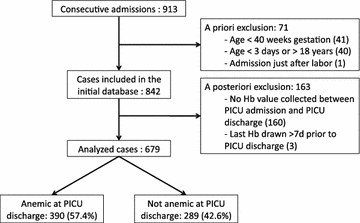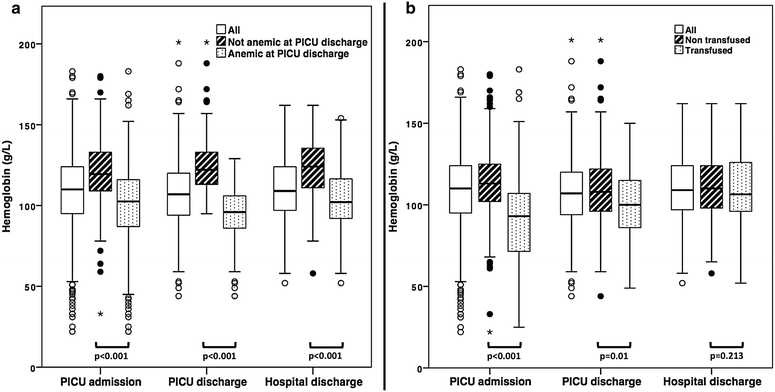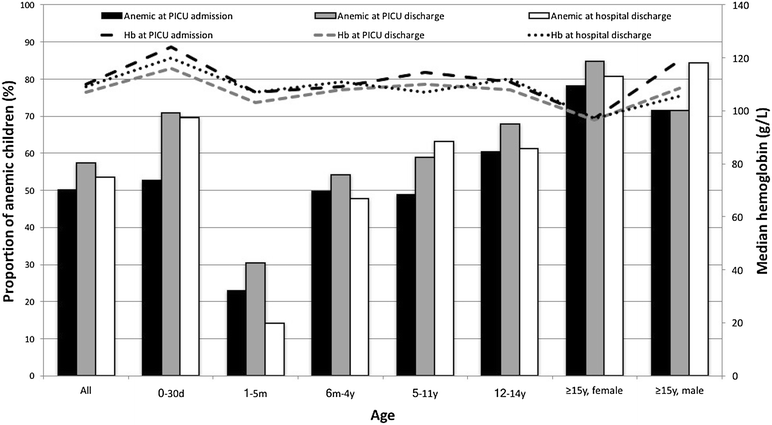Anemia at pediatric intensive care unit discharge: prevalence and risk markers
- PMID: 29067568
- PMCID: PMC5655401
- DOI: 10.1186/s13613-017-0328-8
Anemia at pediatric intensive care unit discharge: prevalence and risk markers
Abstract
Background: Anemia is prevalent at pediatric intensive care unit (PICU) admission and incident during PICU stay, but little is known about anemia at PICU discharge . Anemia after critical illness is an important issue because it could impact post-PICU outcome. We aimed to estimate the prevalence of anemia at PICU discharge and to determine its risk markers.
Methods: This is an ancillary study of a prospective observational study on transfusion practices conducted in the PICU of a tertiary care children's hospital. All children consecutively admitted to the PICU during a 1-year period were considered for inclusion. Data were prospectively collected from medical charts, except for hemoglobin (Hb) levels at PICU and hospital discharge that were collected retrospectively. Anemia was defined by an Hb concentration below the lower limit of the normal range for age.
Results: Among the 679 children retained for analysis, 390 (57.4%) were anemic at PICU discharge. After multivariate adjustment, anemia at PICU admission was the strongest risk marker of anemia at PICU discharge. The strength of this association varied according to age (interaction): The odds ratio (OR) (95% CI) of anemia at PICU discharge was 4.85 (1.67-14.11) for 1-5-month-old infants anemic versus not anemic at PICU admission, and it was 73.13 (13.43, 398.19) for adolescents anemic versus not anemic at PICU admission. Children admitted after a non-cardiac surgery had an increased risk of anemia at PICU discharge [OR 2.30 (1.37, 3.88), p = 0.002]. The proportion of anemic children differed between age categories, while the median Hb level did not exhibit significant variations according to age.
Conclusions: Anemia is highly prevalent at PICU discharge and is strongly predicted by anemia at PICU admission. The usual age-based definitions of anemia may not be relevant for critically ill children. The consequences of anemia at PICU discharge are unknown and deserve further scrutiny.
Keywords: Anemia; Child; Erythrocyte; Outcome; Pediatric; Pediatric intensive care unit.
Figures



Similar articles
-
Anemia after Pediatric Congenital Heart Surgery.J Pediatr Intensive Care. 2021 Mar 23;11(4):308-315. doi: 10.1055/s-0041-1725119. eCollection 2022 Dec. J Pediatr Intensive Care. 2021. PMID: 36388078 Free PMC article.
-
Anemia at Discharge From the PICU: A Bicenter Descriptive Study.Pediatr Crit Care Med. 2019 Sep;20(9):e400-e409. doi: 10.1097/PCC.0000000000002015. Pediatr Crit Care Med. 2019. PMID: 31246740
-
Prevalence and determinants of anemia at discharge in pediatric intensive care survivors.Transfusion. 2023 May;63(5):973-981. doi: 10.1111/trf.17309. Epub 2023 Mar 12. Transfusion. 2023. PMID: 36907652
-
Anemia, blood loss, and blood transfusions in North American children in the intensive care unit.Am J Respir Crit Care Med. 2008 Jul 1;178(1):26-33. doi: 10.1164/rccm.200711-1637OC. Epub 2008 Apr 17. Am J Respir Crit Care Med. 2008. PMID: 18420962
-
Brain-Directed Care: Why Neuroscience Principles Direct PICU Management beyond the ABCs.Children (Basel). 2022 Dec 9;9(12):1938. doi: 10.3390/children9121938. Children (Basel). 2022. PMID: 36553381 Free PMC article. Review.
Cited by
-
Iron Deficiency Anemia in Children During and After PICU Stay: Single-Center Retrospective Cohort, 2021-2022.Pediatr Crit Care Med. 2025 Jan 1;26(1):e62-e66. doi: 10.1097/PCC.0000000000003644. Epub 2024 Nov 22. Pediatr Crit Care Med. 2025. PMID: 39785551
-
Failure to thrive in pediatric patients with congenital heart disease: a cross-sectional study of 13,256 patients.Lancet Reg Health West Pac. 2024 Jan 29;44:101002. doi: 10.1016/j.lanwpc.2023.101002. eCollection 2024 Mar. Lancet Reg Health West Pac. 2024. PMID: 38322730 Free PMC article.
-
Anemia after Pediatric Congenital Heart Surgery.J Pediatr Intensive Care. 2021 Mar 23;11(4):308-315. doi: 10.1055/s-0041-1725119. eCollection 2022 Dec. J Pediatr Intensive Care. 2021. PMID: 36388078 Free PMC article.
References
LinkOut - more resources
Full Text Sources
Other Literature Sources

